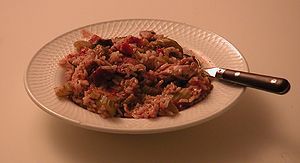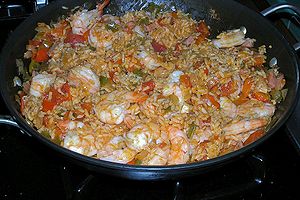Difference between revisions of "Jambalaya" - New World Encyclopedia
Joy Morrow (talk | contribs) |
Joy Morrow (talk | contribs) |
||
| Line 10: | Line 10: | ||
There are two primary methods of making jambalaya, [[Creole]] and [[Cajun]]. | There are two primary methods of making jambalaya, [[Creole]] and [[Cajun]]. | ||
| − | The original and more common, [[Louisiana Creole cuisine|Creole]] jambalaya, is also called "red jambalaya" | + | The original and more common, [[Louisiana Creole cuisine|Creole]] jambalaya, is also called "red jambalaya" because it includes tomatoes. First, meat is added, usually chicken and sausage such as [[andouille]] or smoked sausage. Next [[vegetables]] and [[tomatoes]] are added to cook, followed by [[seafood]]. Rice and [[stock (food)|stock]] are added in equal proportions at the very end. The mixture is brought to a boil and left to simmer for 20 to 60 minutes, depending on the recipe, with infrequent stirring. Towards the end of the cooking process, stirring usually ceases. |
The second style, more characteristic of southwestern and south-central Louisiana, is [[Cajun]] jambalaya, which contains no tomatoes. The meat is browned in a cast-iron pot. The bits of meat that stick to the bottom of the pot are what give a Cajun jambalaya its brown color. A little vegetable oil is added if there is not enough fat in the pot. The [[Holy trinity (cuisine)| trinity]] (of onions, celery, and green bell pepper) is added and sautéed until soft. Stock and seasonings are added in the next step, and then the meats are returned to the pot. This mixture is then simmered, covered, for at least one hour. Lastly, the mixture is brought to a boil and rice is added to the pot. It is then covered and left to simmer over very low heat for at least 1/2 hour without stirring. The dish is finished when the rice has cooked. | The second style, more characteristic of southwestern and south-central Louisiana, is [[Cajun]] jambalaya, which contains no tomatoes. The meat is browned in a cast-iron pot. The bits of meat that stick to the bottom of the pot are what give a Cajun jambalaya its brown color. A little vegetable oil is added if there is not enough fat in the pot. The [[Holy trinity (cuisine)| trinity]] (of onions, celery, and green bell pepper) is added and sautéed until soft. Stock and seasonings are added in the next step, and then the meats are returned to the pot. This mixture is then simmered, covered, for at least one hour. Lastly, the mixture is brought to a boil and rice is added to the pot. It is then covered and left to simmer over very low heat for at least 1/2 hour without stirring. The dish is finished when the rice has cooked. | ||
Revision as of 20:40, 12 February 2009
Jambalaya (pronounced /ˌdʒʌmbəˈlaɪə/ or <jum-buh-LIE-uh>) is a Louisiana Creole casserole-style dish of Spanish and French influence. Jambalaya is traditionally a one pot dish, with a variety of meats and seafood, vegetables and spicy seasonings. The dish is completed by adding raw rice to the pot's stock, and the rich stock flavor is absorbed by the grains as the rice cooks. Rice is the ingredient that distinguishes Jambalaya from gumbos and étouffées, each of which is made without rice but is served over rice that has been prepared separately.
Preparation
There are two primary methods of making jambalaya, Creole and Cajun.
The original and more common, Creole jambalaya, is also called "red jambalaya" because it includes tomatoes. First, meat is added, usually chicken and sausage such as andouille or smoked sausage. Next vegetables and tomatoes are added to cook, followed by seafood. Rice and stock are added in equal proportions at the very end. The mixture is brought to a boil and left to simmer for 20 to 60 minutes, depending on the recipe, with infrequent stirring. Towards the end of the cooking process, stirring usually ceases.
The second style, more characteristic of southwestern and south-central Louisiana, is Cajun jambalaya, which contains no tomatoes. The meat is browned in a cast-iron pot. The bits of meat that stick to the bottom of the pot are what give a Cajun jambalaya its brown color. A little vegetable oil is added if there is not enough fat in the pot. The trinity (of onions, celery, and green bell pepper) is added and sautéed until soft. Stock and seasonings are added in the next step, and then the meats are returned to the pot. This mixture is then simmered, covered, for at least one hour. Lastly, the mixture is brought to a boil and rice is added to the pot. It is then covered and left to simmer over very low heat for at least 1/2 hour without stirring. The dish is finished when the rice has cooked.
A third method is less common. In this version, meat and vegetables are cooked separately from the rice. At the same time, rice is cooked in a savory stock. It is added to the meat and vegetables before serving. This is called "white Jambalaya." This dish is rare in Louisiana as it is seen as a "quick" attempt to make jambalaya, popularized outside the state to shorten cooking time.
Jambalaya is considered by most Louisianians to be a simple to prepare, yet filling, rice dish; gumbos, étouffées, and creoles are considered more difficult to perfect. Most often a long grain white rice is used in making jambalaya.
History
The first appearance of any variant of the word "jambalaya" in any language occurred in "Leis amours de Vanus; vo, Lou paysan oou théâtré," by Fortuné (Fourtunat) Chailan, first published in Provencal in 1837. The earliest appearance of the word in print in English occurs in the May 1849 issue of the American Agriculturalist, page 161, where Solon Robinson refers to a recipe for "Hopping Johnny (jambalaya)." An article in the 1875 “New Orleans Times” said it was “spelled in French jumbliade; but the dish is of Indian origin” and “originally made of zizania aquatica, or wild rice”. Jambalaya did not appear in a cookbook until 1878, when The Gulf City Cook Book, by the Ladies of the St. Francis Street Methodist Episcopal Church, was printed in South Mobile, Alabama. It contains a recipe for “JAM BOLAYA.”
Rice stews have a long lineage in the culinary traditions of the French, Spanish, African, and Native Americana, but jambalaya has a distinct Louisiana parentage in the mélange of native bayou creatures and plant spices melded into the dish. Jambalaya originated from the original European sector of New Orleans and likely was an attempt by the Spanish to make paella in the New World. Saffron was not readily available, so tomatoes became a substitute. Over time, French influence and spices from the Caribbean changed this New World paella into a unique dish. The Cajun version originates from Louisiana's rural, low-lying swamp country where crawfish, shrimp, oysters, alligator, duck, turtle, boar, venison, and other wild game were readily available. Cajun Jambalaya has more of a smoky and spicy flavor than its cousin Creole Jambalaya. [citation needed] It was adopted after absorption of white French Creoles into the Cajun population following their fall from power in New Orleans after the Civil War.
Cultural Significance
The country song written by Moon Mullican and Hank Williams [1] [2] celebrates the dish. Hank Williams Sr copied the Jambalaya musical melody from an earlier tune recorded in Cajun French called "Grand Texas". Cajuns re-recorded Jambalaya with Hank Williams' words translated into Cajun French. Cajuns now consider the song to be one of our own songs. [3]
Jambalaya experienced a brief jump in popularity during the 1920s and 1930s because of its throw-everything-but-the-kitchen-sink-in-the-pot composition. The dish was little more than the rice and vegetables the populace could afford, but the recipe grew from humble roots.
In 1968, Louisiana Governor John J. McKeithen proclaimed Gonzales, Louisiana, the Jambalaya Capital of the World. Every Spring (season), the annual Jambalaya Festival is held in Gonzales. The 2008 world jambalaya champion was Jody Elisar of Gonzales Louisiana.
Jambalaya is also a popular dish in many MREs for the military. Also, Jambalaya was a popular MRE during the crisis of homelessness after Hurricane Katrina.
Etymology
There are many myths about the origin of the name "jambalaya." The most commonly repeated folklore is that the word derives from the combination of the French "jambon" meaning ham, the French article "à la" a contraction of "à la manière de" meaning "in the style of," and "ya," thought to be of West African origin meaning rice. Hence, the dish was named jamb à la ya. European explorers had imported rice from Asia and Africa. Enslaved African already had a native name for this crop; they called it "ya." As Europeans learned the term "ya" for rice, it became included in the name of the dish. However, this theory is largely discredited. Ham is not the signature element of the dish, so there is no reason why it would be featured in the name. Furthermore, there is no known African language in which "ya" means "rice." There are two African languages (Mambila and Grusi-Lyela) in which "ya," or a variant on "ya," refers to the grain sorghum. "Rice" is virtually always some form of "riz" or "arroz."
Another popular (and more likely source) suggests that the word comes from the Spanish "jamon" + "paella," a noted Spanish rice dish. However, the evidence for this idea is also thin. Again, ham is not a featured element of the dish, and Spanish speakers would call a ham paella "paella con jamon," not "jamon paella."
The Dictionary of American Food and Drink offers this creative old wives' tale about the origin of the word "jambalaya":
Late one evening a traveling gentleman stopped by a New Orleans inn which had little food remaining from the evening meal. The traveler instructed the cook, "Jean, balayez!" or "Jean, sweep something together!" in the local dialect. The guest pronounced the resulting hodge-podge dish as "Jean balayez."
This story is believed to be false.
The Oxford English Dictionary indicates that "jambalaya" comes from the Provençal word "jambalaia," meaning a mish-mash or mixup, and also meaning a pilau (pilaf) of rice. This is supported by the fact that the first printed appearance of the word is in a Provençal poem published in 1837.
Similar dishes
- Paella
- Arroz con pollo
- Pilaf/Pilau
- Fried rice
- Rice and peas
- Biryani
- Jollof rice
- Kabsa
- Risotto
- Nasi goreng
ReferencesISBN links support NWE through referral fees
External links
- Cajun jambalaya recipe from Gonzales, Louisiana native.
- Jambalaya Recipe
- Vegetarian Jambalaya
- Chronology of all early mentions of Jambalaya in print.
- Article detailing how to make jambalaya for 120 people
- Anecdotal history of Jambalaya & recipes.
- Award winning Jambalaya recipe.
Credits
New World Encyclopedia writers and editors rewrote and completed the Wikipedia article in accordance with New World Encyclopedia standards. This article abides by terms of the Creative Commons CC-by-sa 3.0 License (CC-by-sa), which may be used and disseminated with proper attribution. Credit is due under the terms of this license that can reference both the New World Encyclopedia contributors and the selfless volunteer contributors of the Wikimedia Foundation. To cite this article click here for a list of acceptable citing formats.The history of earlier contributions by wikipedians is accessible to researchers here:
The history of this article since it was imported to New World Encyclopedia:
Note: Some restrictions may apply to use of individual images which are separately licensed.

